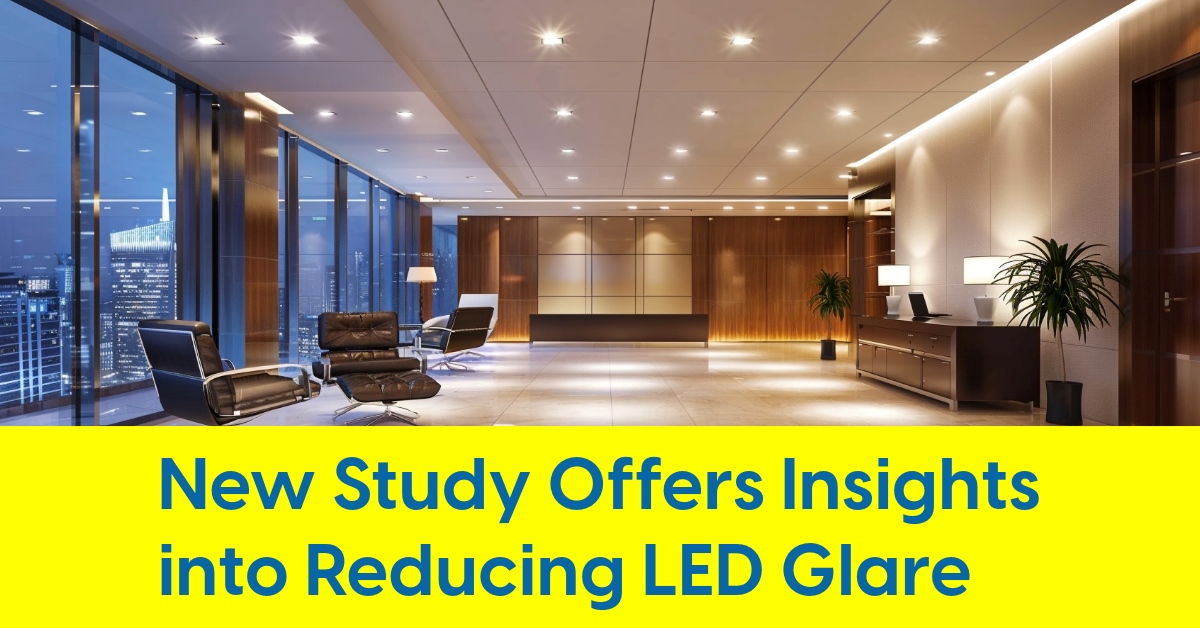April 22, 2024
New Study Offers Insights into Reducing LED Glare

LED Lighting Design: How application of overhead fixtures can be optimized to minimize discomfort
Recent research published last week in LEUKOS, the Journal of the Illuminating Engineering Society, offers new insights into optimizing overhead LED lighting to enhance comfort without compromising on illumination quality. The study, authored by Belal Abboushi, Naomi J. Miller, Eduardo Rodriguez-Feo Bermudez, Lia Irvin, and Michael Royer of the Pacific Northwest National Laboratory in Portland, Oregon, investigates how spectral power distributions (SPD) and background luminance impact the position index of LED sources, affecting glare perception in various environments such as offices and public spaces.
The research is titled, The Position Index of Overhead LED Sources Under Different Spectral Power Distributions and Background Luminances and explores the position index, a metric that evaluates the impact of a light source based on its placement relative to the observer's line of sight.
As Dr. Abboushi summarized in a recent LinkedIn post, “Traditionally, it has been widely believed that light sources positioned above 55° did not cause glare and were therefore disregarded in glare models. However, findings from our recent experiment challenge this notion, revealing that overhead light sources situated at 60° or 80° above the line of sight were indeed perceptible and their position index could be quantified.”
Here are some of the research findings:
Adjusting Spectral Power
Spectral Power Distribution (SPD) is an important factor relating to LED technology. SPD refers to the distribution of power across different wavelengths of light emitted by a source, essentially defining the color composition of the light. This characteristic of LEDs can be adjusted to alter the perceived color and intensity of the light. In practical terms, SPD manipulation involves tuning the balance of wavelengths—especially the blue light spectrum—that an LED emits. This is significant because the human eye's sensitivity varies across different wavelengths, and certain spectrums can cause more visual discomfort than others.
According to the recent study, discomfort glare from overhead LED lighting can be reduced by modifying the SPD to reduce blue light emissions. The presence of blue light is commonly associated with higher glare perception, leading to discomfort in environments like offices where people are exposed for prolonged periods. By adjusting LEDs to emit a warmer color temperature with less blue light content, lighting designers can achieve a dual benefit: reducing the risk of discomfort glare while still providing sufficient illumination for tasks. This approach not only enhances visual comfort but also contributes to maintaining the functional aspects of lighting essential for both work efficiency and safety in various settings.
The Position Index: Strategic LED Placement
The research explores the position index, a metric that evaluates the impact of a light source based on its placement relative to the observer's line of sight.
The researchers outline how this metric is essential for determining the optimal vertical and horizontal angles for LED installations to minimize direct glare. By adjusting these angles, lighting designers can significantly enhance visual comfort, reducing the strain on the eyes caused by excessive brightness. This strategic placement not only improves the user experience but also contributes to the broader goals of energy efficiency and environmental adaptability in lighting design.
Modifying Background Luminance
In environments where LED lighting is prominent, glare perception is influenced by the background luminance. When the background luminance is too high or too low compared to the brightness of the light source, it can cause discomfort and reduce the quality of visual perception. By carefully controlling the luminance levels of the surrounding environment, such as adjusting the ambient lighting to create a balance that reduces glare and enhances comfort, lighting designers can improve user experiences in both workplaces and public areas.
Additionally, the implementation of adaptive lighting systems presents a technologically advanced solution to managing glare. These systems automatically adjust the intensity and characteristics of the light based on real-time changes in background luminance. This dynamic adjustment not only helps in maintaining consistent visual comfort but also contributes to energy efficiency by modulating light output as needed, ensuring that the lighting is neither too harsh nor too dim for the given environmental conditions.
Utilizing Prediction Models
The research suggests that utilizing prediction models could bean important aspect of modern lighting design, especially when it comes to mitigating the negative effects of discomfort glare from overhead LED fixtures. These models are sophisticated tools that evaluate potential glare by analyzing several variables that influence visual comfort. Key factors include the luminance of the glare source, which is its intensity as perceived by the human eye; the size of the glare source, which affects how light is distributed across the observer's field of view; and the background luminance, which refers to the brightness of the surrounding environment.
By integrating these parameters, glare prediction models enable designers to strategically place LED fixtures in a manner that minimizes discomfort while ensuring sufficient illumination for the intended space.
This new study contributes significantly to the field by providing actionable strategies that can be employed to design more comfortable and efficient lighting environments. The research indicates that future lighting designs could benefit from these insights, potentially leading to improved applications of LED technology that prioritize both energy efficiency and visual comfort.










